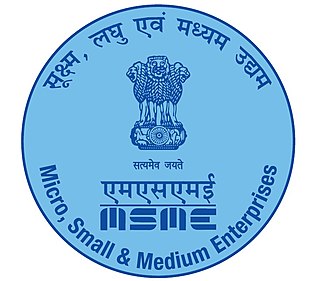Related Research Articles

The Swadeshi movement was a self-sufficiency movement that was part of the Indian independence movement and contributed to the development of Indian nationalism. Before the BML Government's decision for the partition of Bengal was made public in December 1903, there was a lot of growing discontentment among the Indians. In response the Swadeshi movement was formally started from Town Hall Calcutta on 7 August 1905 to curb foreign goods by relying on domestic production. Mahatma Gandhi described it as the soul of swaraj (self-rule). The movement took its vast size and shape after rich Indians donated money and land dedicated to Khadi and Gramodyog societies which started cloth production in every household. It also included other village industries so as to make village self-sufficient and self-reliant. The Indian National Congress used this movement as arsenal for its freedom struggle and ultimately on 15 August 1947, a hand-spun Khadi 'tricolor ashok chakra' Indian flag was unfurled at 'Princess Park' near India Gate, New Delhi by Pandit Nehru.

Khadi, derived from khaddar, is a hand-spun and woven natural fibre cloth promoted by Mahatma Gandhi as swadeshi (self-sufficiency) for the freedom struggle of the Indian subcontinent, and the term is used throughout India, Pakistan and Bangladesh. The first piece of the hand-woven cloth was manufactured in the Sabarmati Ashram during 1917–18. The coarseness of the cloth led Gandhi to call it khadi. The cloth is made from cotton, but it may also include silk or wool, which are all spun into yarn on a charkha. It is a versatile fabric that remains cool in summer and warm in winter. To improve its appearance, khadi is sometimes starched to give it a stiffer feel. It is widely accepted in various fashion circles. Popular dresses are made using khadi cloth such as dhoti, kurta, and handloom saris such as Puttapaka Saree, Kotpad Handloom fabrics, Chamba Rumal, and Tussar silk. Gajam Anjaiah, an Indian master handloom designer and a recipient of the Padma Shri, is known for his innovation and development of tie-dye handloom products along with the Telia Rumal technique of weaving products based on the Ikat process.

Dayanidhi Murasoli Maran is an Indian politician and one of the prominent members of Dravida Munnetra Kazhagam party. He was elected thrice as a Member of Parliament to Lok Sabha from Chennai Central constituency during the 2004 general elections, 2009 general elections & 2019 general elections.

The Ministry of Textiles is an Indian government national agency responsible for the formulation of policy, planning, development, export promotion and regulation of the textile industry in India. This includes all natural, artificial, and cellulosic fibers that go into the making of textiles, clothing and Handicrafts.

Pupul Jayakar was an Indian cultural activist and writer, best known for her work on the revival of traditional and village arts, handlooms, and handicrafts in post-independence India. According to The New York Times, she was known as "India's 'czarina of culture'", and founded arts festivals that promoted Indian arts in France, Japan, and the United States. She was a friend and biographer to both the Nehru-Gandhi family and J Krishnamurti. Jayakar had a close relationship with three prime ministers: Jawaharlal Nehru, his daughter Indira Gandhi and her son Rajiv Gandhi, and she was a close friend of Indira Gandhi. She served as cultural adviser to the latter two, confirming her preeminence in cultural matters.

The economy of Uttar Pradesh is the third largest of all the states in India. Nominal GDP of the state for the year 2022-23 is ₹20.48 trillion (US$260 billion). Uttar Pradesh has an urban population of 4,44,95,063. According to the 2011 census report, 22.76% of Uttar Pradesh's population lives in urban areas. The state has 7 cities with populations exceeding 10 lakh each. After partition in 2000, the new Uttar Pradesh state produces about 92% of the economic output of the old Uttar Pradesh state. According to Planning Commission estimates for the year 2011–12, 29.4% of the state's total population was poor. However, updated findings by NITI Aayog based on NFHS-4 (2015–16), 37.79% of the population was found to be poor.

The Ministry of Micro, Small and Medium Enterprises is the ministry in the Government of India. It is the apex executive body for the formulation and administration of rules, regulations and laws relating to micro, small and medium enterprises in India. The Minister of Micro, Small and Medium Enterprises is Narayan Rane.
Weaving and cloth trading communities of Western India particularly of Gujarat are called Vankar/Wankar/Vaniya. The four major woven fabrics produced by these communities are cotton, silk, khadi and linen. Today majority of these community members are not engaged in their ancestral weaving occupation still some population of these community contribute themselves in traditional handloom weaving of famous Patola of Patan, Kachchh shawl of Bhujodi in Kutch, Gharchola and Crotchet of Jamnagar, Zari of Surat, Mashroo of Patan and Mandvi in Kutch, Bandhani of Jamnagar, Anjar and Bhuj, Motif, Leheria, Dhamakda and Ajrak, Nagri sari, Tangaliya Shawl, Dhurrie, Kediyu, Heer Bharat, Abhala, Phento and art of Gudri. Vankar is described as a caste as well as a community.

The Tamil Nadu Handloom Weavers' Cooperative Society, popularly known as Co-optex, is a cooperative of traditional handloom weavers of the Indian state of Tamil Nadu. This is under the control of Department of Handlooms, Handicrafts, Textiles and Khadi of Government of Tamil Nadu. The organisation owns a number of shopping outlets in Tamil Nadu. Co-Optex also has an international arm, Co-optex International which exports its products to Germany, France, Netherlands, Belgium, Spain, Switzerland, Canada, Greece, Hong Kong, U.K. South Africa and the U.A.E.
The textile industry in India traditionally, after agriculture, is the only industry that has generated huge employment for both skilled and unskilled labour. The textile industry continues to be the second-largest employment generating sector in India. It offers direct employment to over 35 million people in the country. India is the world's second largest exporter of textiles and clothing, and in the fiscal year 2022, the exports stood at US$ 44.4 billion. According to the Ministry of Textiles, the share of textiles in total exports during April–July 2010 was 11.04%. During 2009–2010, the Indian textile industry was pegged at US$55 billion, 64% of which services domestic demand. In 2010, there were 2,500 textile weaving factories and 4,135 textile finishing factories in all of India. According to AT Kearney’s ‘Retail Apparel Index’, India was ranked as the fourth most promising market for apparel retailers in 2009.
Gujarat State Handloom and Handicrafts Development Corporation Ltd is an agency of Government of Gujarat established in 1973 with the main objective of identification, revival, development of handicrafts and handlooms of Gujarat.The Corporation markets products of artisans through its Garvi-Gurjari chain of emporiums in India and supply to exporters.
Jharkhand Silk Textile and Handicraft Development Corporation (Jharcraft) is an agency of Government of Jharkhand established in 2006 with the objective to develop and support Sericulture farmers, weavers and artisans of Jharkhand. The organization implements the government-funded schemes to promote tussar silk, handloom and handicraft of the state. The company is incorporated under Companies Act, 1956 to act as an implementing agency. Its area of concern is the handloom, handicraft, and sericulture sectors. The activities are based in the interior areas of the state and the organization works basically on the SHG, NGO and Project modules. Work-sheds are built within the villages with all necessary facilities for the artisans and weavers to work at the nearest place from their houses. Other facilities including training, raw materials, etc. are also provided to them in these work-sheds for uninterrupted work. These artisans are supervised by the master trainers and qualified cluster managers & project managers throughout. This is to check the quality standards of the commodities produced.

Indian Institutes of Handloom Technology (IIHTs) are government run public institutes of higher education in the handloom sector. There are six institutes in central sector and four in State sector. All IIHTs provide a three-year Diploma in Handloom and Textile Technology. The Varanasi and Salem campuses also offer a one and half year Post Diploma in Textile Processing.The Salem campus also offer a four-year B.Tech. Degree in Handloom and Textile Technology.

Gajam Anjaiah, an Indian master handloom designer, who is widely recognised in the handloom industry for his innovations and developments of Tie and Dye handloom products along with Telia Rumal technique of weaving based on Ikat tie-dye process. He received Padma Shri from Government of India under Art category in 2013. He is known for his excellence in traditional handloom design works, such as Puttapaka Sarees in Tie and dye skill, that is the traditional art of designing on paper and then transferring it on to cloth. His dedication to the Handloom Industry has kept the Indian tradition of weaving alive, brought livelihood to the weavers and gave exclusive/unique designed handloom products to the people in India.

Handloom saris are a traditional textile art of Bangladesh and India. The production of handloom saris are important for economic development in rural India.
Kunja Bihari Meher was an Indian master craftsman and weaver from Odisha. Born in the Bargarh district, he is known for the Ikkat tradition of weaving, found in the Sambalpuri sarees of Odisha, and is credited with the development of Sambalpuri handloom industry. He was awarded the fourth highest civilian award of the Padma Shri by the Government of India, in 1998. He won the National Award for Handicrafts of the National Centre for Textile Design in 2009. His son, Surendra Meher, is also a known weaver.
Neelamani Devi is an Indian craftswoman and master potter from Manipur. Her creations have been the theme of two documentary films; Mittee aur Manab by renowned filmmaker, Mani Kaul, and Nilamani: The Master Potter of Manipur, by Aribam Syam Sharma. The TV Series, Mahabharata also featured her works on one of the episodes. The Government of India awarded her the fourth highest civilian honour of the Padma Shri, in 2007, for her contributions to the art of pottery making.

Habaspuri is a cotton-based traditional handloom textiles of Odisha, India. Habaspuri sari is a major product of this textile. The Kondha weavers of Chicheguda, Kalahandi district, Odisha are originally attributed for weaving of the Habaspuri fabric. For its uniqueness in weaving, design and production, it has been identified as one of the 14 Geographical Indications of Odisha. The textile has traditional patterns of the region like kumbha (temple), fish and flowers.
Kotpad Handloom is a vegetable-dyed fabric woven by the tribal weavers of the Mirgan community of Kotpad village in Koraput district, Odisha, India. Cotton sarees with solid border and Pata Anchal, duppatta with typical Buties / motifs, Scolrfs on cotton, silk, handloom stoles, and dress materials are all dyed with organic dyes. The natural dye is manufactured from the aul tree grown in this area. The Kotpad tussar silk saree with tribal art and Kotpad handloom fabrics with natural color is its specialty.
Suraiya Hasan Bose was an Indian textile conservator, textile designer, and manufacturer, who worked to preserve traditional Indian textile art and techniques. She worked with the Indian Cottage Industries Emporium, as well as the Indian Handloom and Handicrafts Export Corporation, later establishing her own textile manufacturing unit to create traditional Indian textiles. Her designs have been exhibited in the Victoria and Albert Museum.
References
- ↑ "Public Sector Undertakings". Ministry of Textiles. Archived from the original on 2014-02-22. Retrieved 2013-09-16.
- ↑ "Archived copy". Archived from the original on 2012-11-04. Retrieved 2012-11-05.
{{cite web}}: CS1 maint: archived copy as title (link) - ↑ "GoI approves closure of HHEC" . Retrieved 2021-03-17.